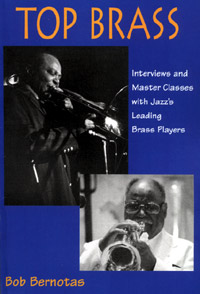Top Brass by Bob Bernotas: A Review
 Top Brass: Interviews and Master Classes With Jazz's Leading Brass Players. Bob Bernotas. Boptism Music, New York. 2001.
Top Brass: Interviews and Master Classes With Jazz's Leading Brass Players. Bob Bernotas. Boptism Music, New York. 2001.
Top Brass is a quodlibet of interviews, articles, and anecdotes compiled by jazz journalist, historian, and trombone player Bob Bernotas over the past decade. Many of the chapters were published in a shortened, edited form in various jazz and wind publications as well as via the Online Trombone Journal. The short chapters feature the knowledge, personality, and experiences of some of the great jazz musicians of the last half of the 20th century including Clark Terry, Art Farmer, Al Grey, J. J. Johnson, Slide Hampton and other luminaries.
The book is divided into three sections, Portraits and Sketches, Conversations, and Master Classes. The Portraits and Sketches section contain vignettes with brief interludes into the lives of famous jazz performers. The personality, life style, and musical philosophy of the master musicians are extracted from the cut in time that is the source of each article. The life of an American jazz musician is not without some sense of rejection and loss due to the lack of respect shown to America’s original art form in the land of its birth. This sense of loss is a common thread that runs through the vignettes as well as the Conversations section.
Mr. Bernotas demonstrates his considerable skill as a journalist in the Conversations section. He draws the best out of the jazz artists with open-ended questions that allow the artists to tell their stories in their own words. Oftentimes, the answers stretch for several pages giving a glimpse into the intellect, experiences, and regrets of the performers. Bernotas allows the interviewees to speak with their own voice including the slang and vulgarity that is common among many jazz musicians. The angst of loss mentioned earlier is often close to surface with many of the performers, yet the love and respect for the music and art form is equally apparent. This portion of the book is perhaps the most insightful and significant of the three sections due to the degree of rapport that is established with the artists and the resulting openness of their conversation.
The Master Classes that conclude the book are short essays on specific areas of musicianship; many with particular emphasis on jazz performance. The essays do not go into great detail or have musical examples of exercises, but serve as brief introductions to specific concepts such as use of the plunger, half-valve technique, pentatonic improvisation, and multi-phonics. Broader concepts such as doubling, low brass writing peculiarities, programming tips, clean attacks, and developing a personal solo style are also introduced by many of the jazz greats interviewed and profiled earlier in the book.
Top Brass is an apparent labor of love that provides the reader with an intimate visit with many of the best jazz musicians of our day. Interestingly, probably due to the taste of the author and of special interest to Online Trombone Journal readers, trombone players are heavily featured throughout the three sections of the book. For readers interested in the lives, philosophies, and idiosyncrasies of famous jazz brass players, this book will bring a great deal of pleasure and information.
